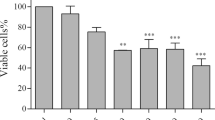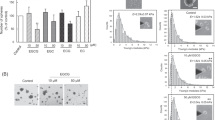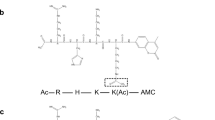Abstract
During a search to identify resveratrol (3,5,4′-trihydroxy-trans-stilbene, RV) target genes in the human erythroleukemic K562 cell line, we show here that the tensin gene and protein levels are remarkably induced by this dietary polyphenol. Tensin, a cell–matrix adhesion protein binding the integrins and cytoskeletal actin filaments also interacts with PI3-kinase and JNK signaling pathways. Tensin induction by RV is associated with increased K562 cell adhesion to fibronectin, cell spreading and actin polymerization. The same responses were observed in the tensin-deficient MCF7 human breast cancer cell line. In K562 and MCF7 cells treated by RV, tensin was found in punctate and intracytoplasmic areas. In MCF7 epithelial cells, induction of tensin is not exclusively associated with plasma membrane-bound vinculin, suggesting a dual localization of tensin in both focal and fibrillar adhesions. Pharmacological blockade of PI3-kinase and Rho GTPases/Rho-kinase resulted in selective depletion of focal adhesions, disorganization of tensin localization and disruption of stress fibers. RV increased cell motility and attachment to fibronectin in MCF7 cells submitted to mechanical laminar flow stress, and abrogated estrogen-induced MCF7 cancer cell invasion. Our data support the conclusion that induction of tensin by RV contributes to the chemopreventive and anti-invasive activity of this natural dietary compound in tensin-negative and -deficient leukemic cells or epithelioid cancers.
This is a preview of subscription content, access via your institution
Access options
Subscribe to this journal
Receive 50 print issues and online access
$259.00 per year
only $5.18 per issue
Buy this article
- Purchase on Springer Link
- Instant access to full article PDF
Prices may be subject to local taxes which are calculated during checkout






Similar content being viewed by others
References
Adlercreutz H, Mousavi Y, Clark J, Hockerstedt K, Hamalainen E, Wahala K, Makela T and Hase T . (1992). J. Steroid Biochem. Mol. Biol., 41, 331–337.
Ahmad N, Adhami VM, Afaq F, Feyes DK and Mukhtar H . (2001). Clin. Cancer Res., 7, 1466–1473.
Auger K, Songyang Z, Lo S, Roberts T and Chen L . (1996). J. Biol. Chem., 271, 23452–23457.
Button E, Shapland C and Lawson D . (1995). Cell Motil. Cytoskeleton, 30, 247–251.
Cavailles V, Gompel A, Portois MC, Thenot S, Mabon N and Vignon F . (2002). J. Mol. Endocrinol., 28, 165–175.
Chen H, Duncan I, Bozorgchami H and Lo S . (2002). Proc. Natl. Acad. Sci USA, 99, 733–738.
Chen H, Ishii A, Wong WK, Chen LB and Lo SH . (2000). Biochem. J., 351 (Part 2), 403–411.
Clement MV, Hirpara JL, Chawdhury SH and Pervaiz S . (1998). Blood, 92, 996–1002.
Danen E, Sonneveld P, Brakebusch C, Fassler R and Sonnenberg A . (2002). J. Cell Biol., 159, 1071–1086.
Dong Z . (2003). Mutat. Res., 523–524, 145–150.
Dorrie J, Gerauer H, Wachter Y and Zunino SJ . (2001). Cancer Res., 61, 4731–4739.
Drexler HG, MacLeod RA and Uphoff CC . (1999). Leukemia Res., 23, 207–215.
Entschladen F and Zanker KS . (2000). J. Cancer Res. Clin. Oncol., 126, 671–681.
Ferry-Dumazet H, Garnier O, Mamani-Matsuda M, Vercauteren J, Belloc F, Billiard C, Dupouy M, Thiolat D, Kolb JP, Marit G, Reiffers J and Mossalayi DM . (2002). Carcinogenesis, 23, 1327–1333.
Fontecave M, Lepoivre M, Elleingand E, Gerez C and Guittet O . (1998). FEBS Lett., 421, 277–279.
Fulda S and Debatin KM . (2004). Cancer Res., 64, 337–346.
Galbraith C, Yamada K and Sheetz M . (2002). J. Cell Biol., 159, 695–705.
Golla R, Philp N, Safer D, Chintapalli J, Hoffman R, Collins L and Nachmias VT . (1997). Cell Motil. Cytoskeleton, 38, 187–200.
Gordon MY, Dowding CR, Riley GP, Goldman JM and Greaves MF . (1987). Nature, 328, 342–344.
Hall AK, Chen SC, Hempstead JL and Morgan JL . (1991). J. Neurochem., 56, 462–468.
Howitz KT, Bitterman KJ, Cohen HY, Lamming DW, Lavu S, Wood JG, Zipkin RE, Chung P, Kisielewski A, Zhang LL, Scherer B and Sinclair DA . (2003). Nature, 425, 191–196.
Huff T, Muller CS, Otto AM, Netzker R and Hannappel E . (2001). Int. J. Biochem. Cell Biol., 33, 205–220.
Jang M, Cai L, Udeani GO, Slowing KV, Thomas CF, Beecher CW, Fong HH, Farnsworth NR, Kinghorn AD, Mehta RG, Moon RC and Pezzuto JM . (1997). Science, 275, 218–220.
Levesque JP and Simmons PJ . (1999). Exp. Hematol., 27, 579–586.
Mahyar-Roemer M, Katsen A, Mestres P and Roemer K . (2001). Int. J. Cancer, 94, 615–622.
Maxwell PJ, Longley DB, Latif T, Boyer J, Allen W, Lynch M, McDermott U, Harkin DP, Allegra CJ and Johnston PG . (2003). Cancer Res., 63, 4602–4606.
Opipari Jr AW, Tan L, Boitano AE, Sorenson DR, Aurora A and Liu JR . (2004). Cancer Res., 64, 696–703.
Otto AM, Muller CS, Huff T and Hannappel E . (2002). J. Cancer Res. Clin. Oncol., 128, 247–256.
Park JW, Choi YJ, Suh SI, Baek WK, Suh MH, Jin IN, Min DS, Woo JH, Chang JS, Passaniti A, Lee YH and Kwon TK . (2001). Carcinogenesis, 22, 1633–1639.
Pokorna E, Jordan PW, O'Neill CH, Zicha D, Gilbert CS and Vesely P . (1994). Cell Motil. Cytoskeleton, 28, 25–33.
Pozo-Guisado E, Alvarez-Barrientos A, Mulero-Navarro S, Santiago-Josefat B and Fernandez-Salguero PM . (2002). Biochem. Pharmacol., 64, 1375–1386.
Rodrigue CM, Arous N, Bachir D, Smith-Ravin J, Romeo PH, Galacteros F and Garel MC . (2001). Br. J. Haematol., 113, 500–507.
Salesse S and Verfaillie C . (2002). Oncogene, 21, 8605–8611.
Salgia R, Pisick E, Sattler M, Li J, Uemura N, Wong W, Burky S, Hirai H, Chen L and Griffin J . (1996). J. Biol. Chem., 271, 25198–25203.
Santelli G, Califano D, Chiappetta G, Vento MT, Bartoli PC, Zullo F, Trapasso F, Viglietto G and Fusco A . (1999). Am. J. Pathol., 155, 799–804.
Schneider Y, Vincent F, Duranton B, Badolo L, Gosse F, Bergmann C, Seiler N and Raul F . (2000). Cancer Letter, 158, 85–91.
Shimamura R, Kudo J, Kondo H, Dohmen K, Gondo H, Okamura S, Ishibashi H and Niho Y . (1990). Blood, 76, 977–984.
Sun HQ, Kwiatkowska K and Yin HL . (1996). J. Biol. Chem., 271, 9223–9230.
Sun N, Woo S, Cassady J and Snapka R . (1998). J. Nat. Prod., 61, 362–366.
Tikoo A, Cutler H, Lo SH, Chen LB and Maruta H . (1999). Cancer J. Sci. Am., 5, 293–300.
Tikoo A, Shakri R, Connolly L, Hirokawa Y, Shishido T, Bowers B, Ye LH, Kohama K, Simpson RJ and Maruta H . (2000). Cancer J., 6, 162–168.
Tinhofer I, Bernhard D, Senfter M, Anether G, Loeffler M, Kroemer G, Kofler R, Csordas A and Greil R . (2001). FASEB J., 15, 1613–1615.
Torgler C, Narasimha M, Knox A, Zervas C, Vernon M and Brown N . (2004). Dev. Cell, 3, 357–369.
Uenobe F, Nakamura S and Miyazawa M . (1997). Mutat. Res., 373, 197–200.
Vleminckx K, Vakaet LJ, Mareel M, Fiers W and van Roy F . (1991). Cell, 66, 107–119.
Wang M, Jin Y and Ho CT . (1999). J. Agric. Food Chem., 47, 3974–3977.
Yu FX, Lin SC, Morrison-Bogorad M, Atkinson MA and Yin HL . (1993). J. Biol. Chem., 268, 502–509.
Zamir E and Geiger B . (2001). J. Cell Sci., 114, 3583–3590.
Zamir E, Katz BZ, Aota S, Yamada KM, Geiger B and Kam Z . (1999). J. Cell Sci., 112 (Part 11), 1655–1669.
Zamir E, Katz M, Posen Y, Erez N, Yamada KM, Katz BZ, Lin S, Lin DC, Bershadsky A, Kam Z and Geiger B . (2000). Nat. Cell Biol., 2, 191–196.
Acknowledgements
We would like to express our gratitude to Dr Lo for providing the polyclonal human anti-tensin antibody. We also acknowledge Evelyne Souil (Plate-Forme d'Histologie, Institut Cochin) for her help in adhesion and immunofluorescence studies. We thank Nicole Arous for assistance in the RFDD approach and Frank Letourneur and Nicolas Lebrun for cDNA sequencing. This study was supported by INSERM, FORTIS Bank, and a postdoctoral fellowship, from Aventis (CMR).
Author information
Authors and Affiliations
Corresponding author
Rights and permissions
About this article
Cite this article
Rodrigue, C., Porteu, F., Navarro, N. et al. The cancer chemopreventive agent resveratrol induces tensin, a cell–matrix adhesion protein with signaling and antitumor activities. Oncogene 24, 3274–3284 (2005). https://doi.org/10.1038/sj.onc.1208485
Received:
Revised:
Accepted:
Published:
Issue Date:
DOI: https://doi.org/10.1038/sj.onc.1208485



